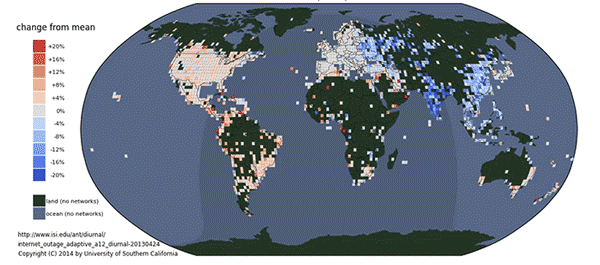USC Viterbi researchers studying how big the Internet is have found that it “sleeps,” almost like a living creature.
This finding should help scientists and policymakers develop better systems to measure and track Internet outages, such as those that struck the New York area after Hurricane Sandy in 2012. Understanding that the Internet sleeps will help them avoid confusing a sleeping Internet with an outage.

“The Internet is important in our lives and businesses, from streaming movies to buying online. Measuring network outages is a first step to improving Internet reliability,” said John Heidemann, a research professor at USC Viterbi’s Information Sciences Institute (ISI), and the study’s corresponding author. Heidemann collaborated with former USC Viterbi Ph.D. student Lin Quan and ISI’s Yuri Pradkin on the study, which was presented at the 2014 ACM Internet Measurements Conference in November.
While the Internet is always up and running for some—such as those with broadband access in the United States and Western Europe—in other areas, access varies over the course of the day, notably in Asia, South America and Eastern Europe.
The study also correlates countries with strong diurnal Internet access with lower GDP, meaning that the richer a country is, the more likely it is that the Internet will be up and running 24/7.
This work is one of the first to explore how networking policies affect how the network is used,” Heidemann said.
There are some 4 billion IPv4 Internet addresses. Heidemann and his team pinged about 3.7 million address blocks (representing about 950 million addresses) every 11 minutes over the span of two months, looking for daily patterns.

“This data helps us establish a baseline for the Internet—to understand how it functions so that we have a better idea of how resilient it is as a whole and can spot problems quicker,” Heidemann explained.
The team’s work is ongoing. “We have grown our coverage to 4 million blocks [more than 1 billion addresses] as Internet use grows,” Heidemann said. He hopes that long-term observations will help guide Internet operation.




